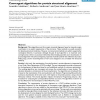1578 search results - page 71 / 316 » Algorithmic randomness of continuous functions |
BMCBI
2007
14 years 10 months ago
2007
Background: Many algorithms exist for protein structural alignment, based on internal protein coordinates or on explicit superposition of the structures. These methods are usually...
118
click to vote
ESOP
2011
Springer
14 years 1 months ago
2011
Springer
Abstract. The Bayesian approach to machine learning amounts to inferring posterior distributions of random variables from a probabilistic model of how the variables are related (th...
119
click to vote
FOIKS
2008
Springer
15 years 6 months ago
2008
Springer
Supervised learning deals with the inference of a distribution over an output or label space $\CY$ conditioned on points in an observation space $\CX$, given a training dataset $D$...
SPAA
1997
ACM
15 years 1 months ago
1997
ACM
Consider a set of shared objects in a distributed network, where several copies of each object may exist at any given time. To ensure both fast access to the objects as well as e ...
101
click to vote
FOCS
1999
IEEE
15 years 2 months ago
1999
IEEE
Various efforts ([?, ?, ?]) have been made in recent years to derandomize probabilistic algorithms using the complexity theoretic assumption that there exists a problem in E = dti...

